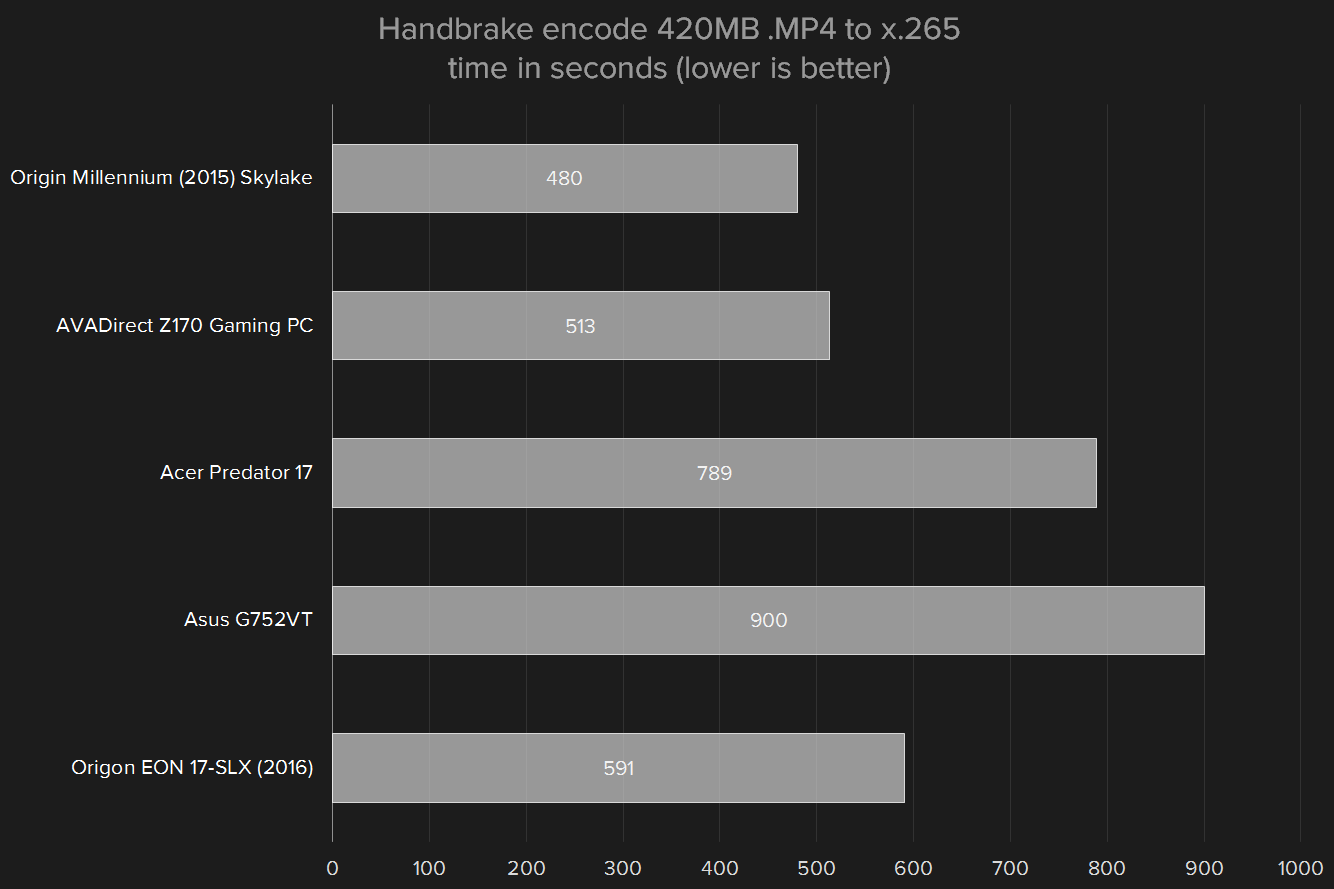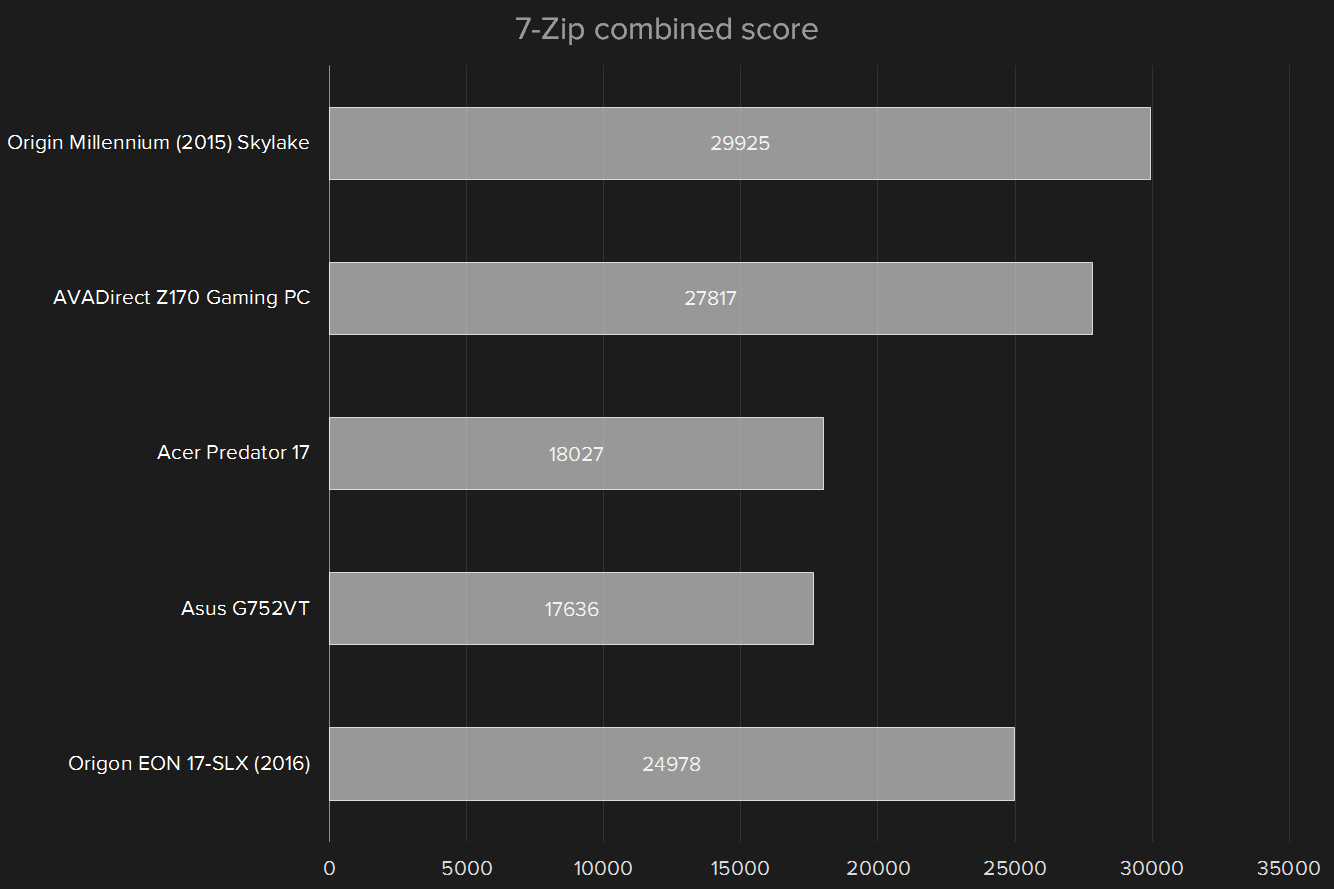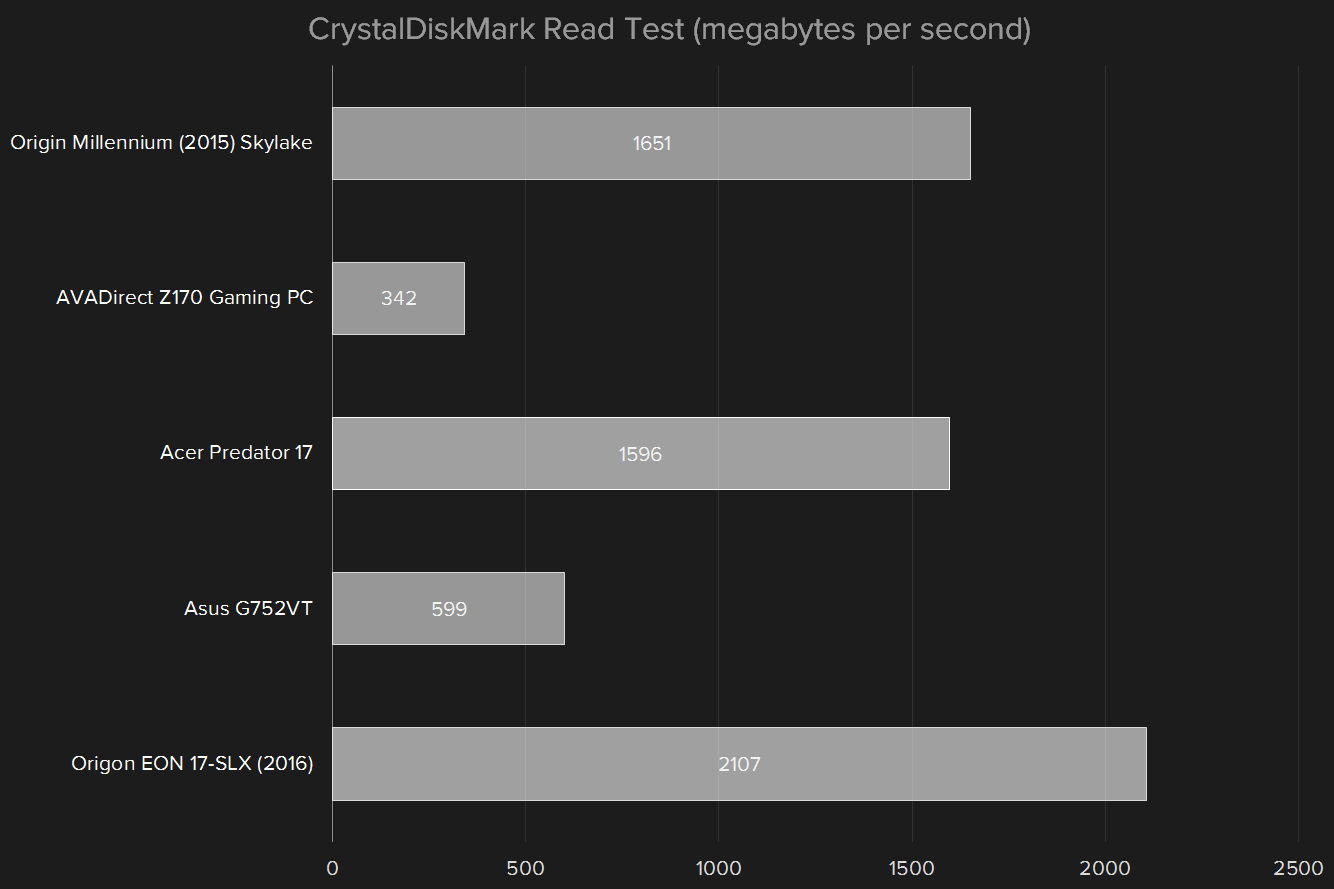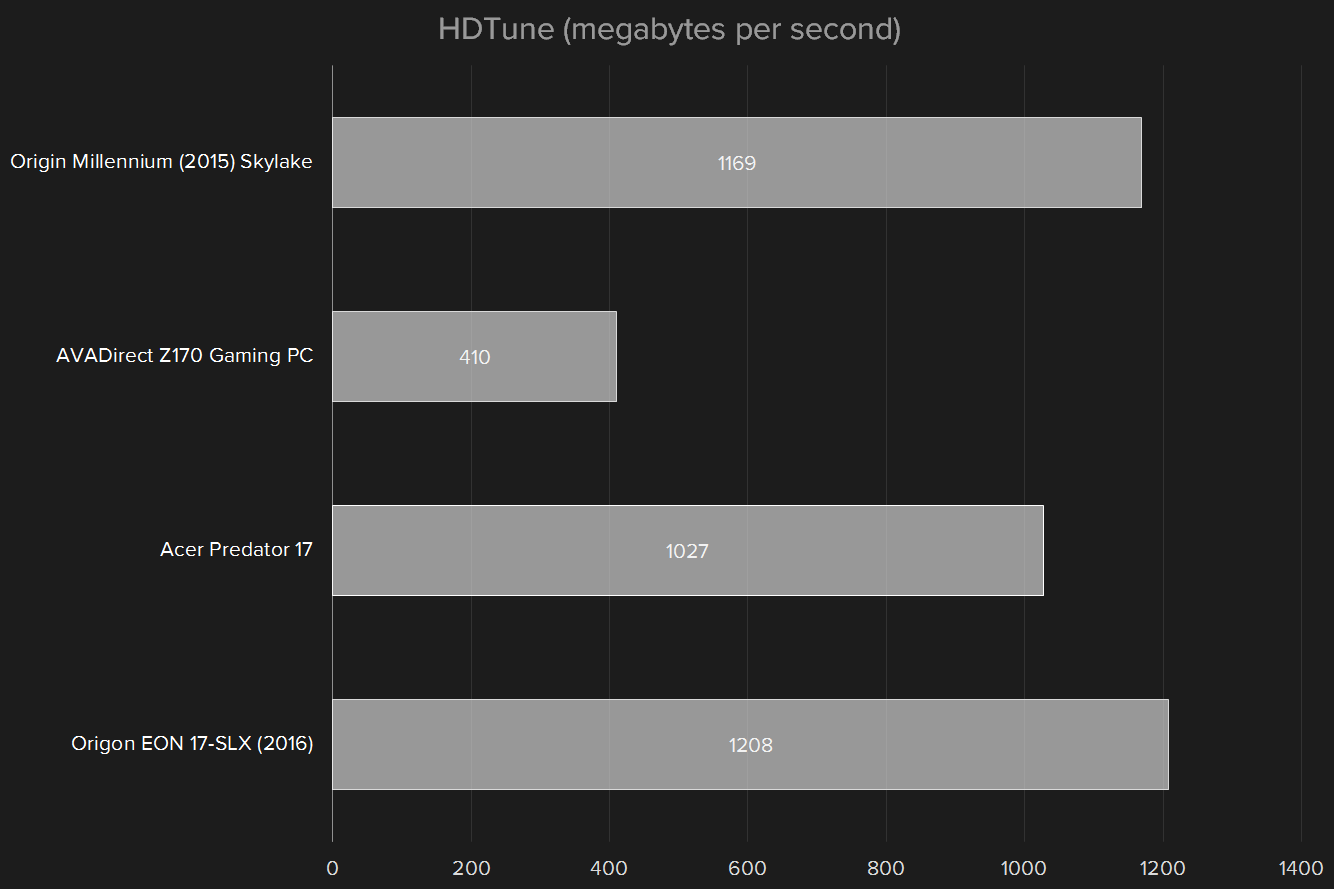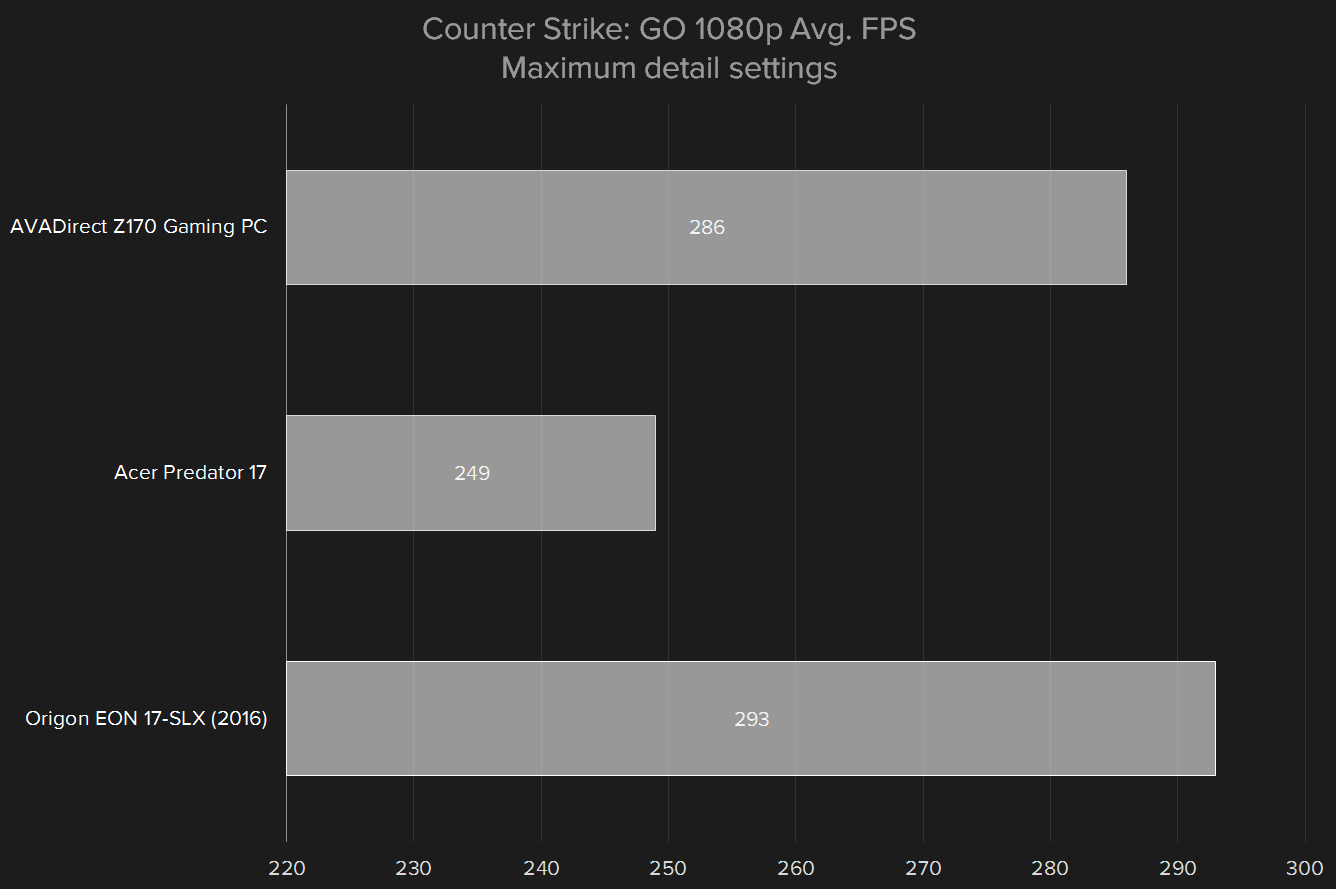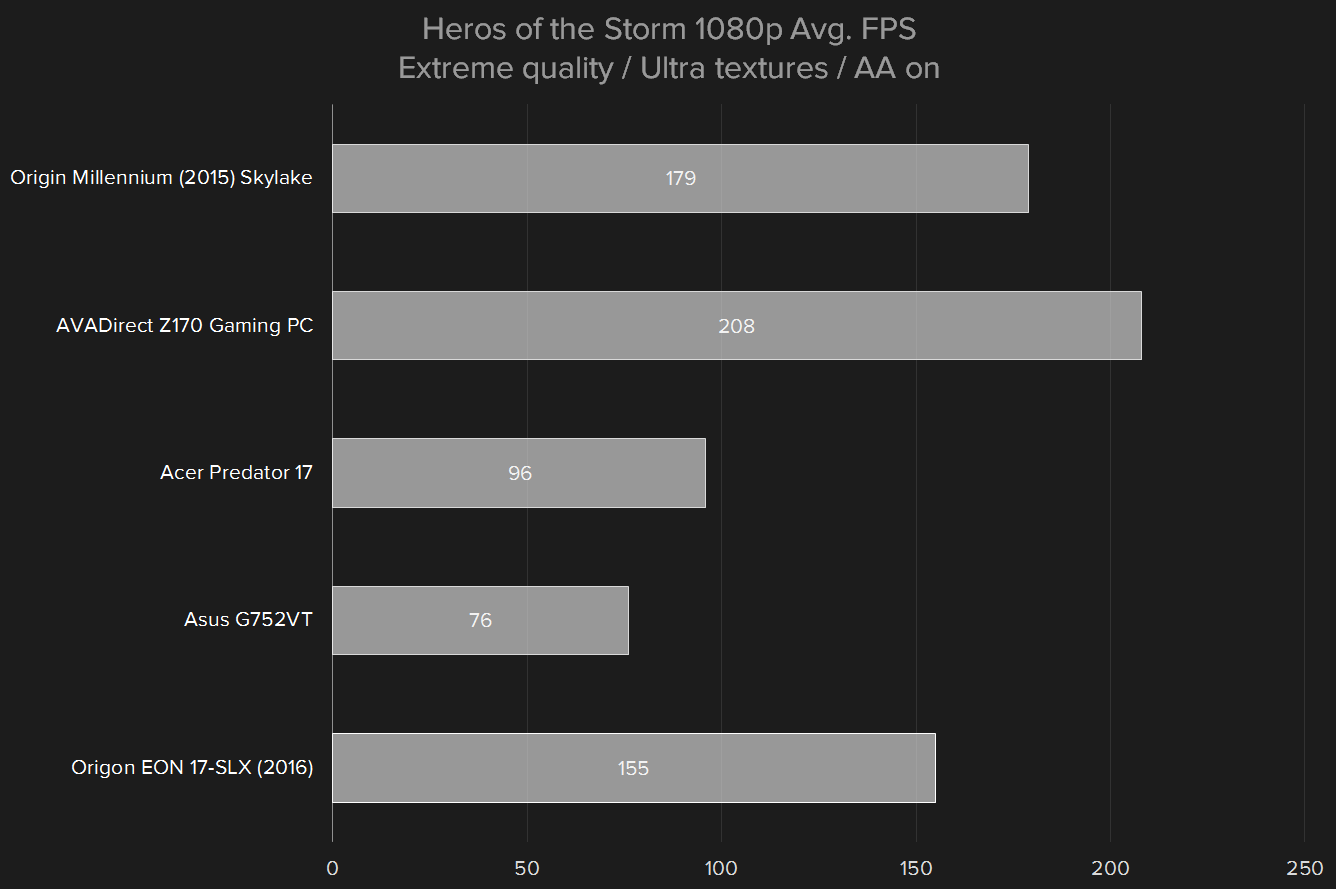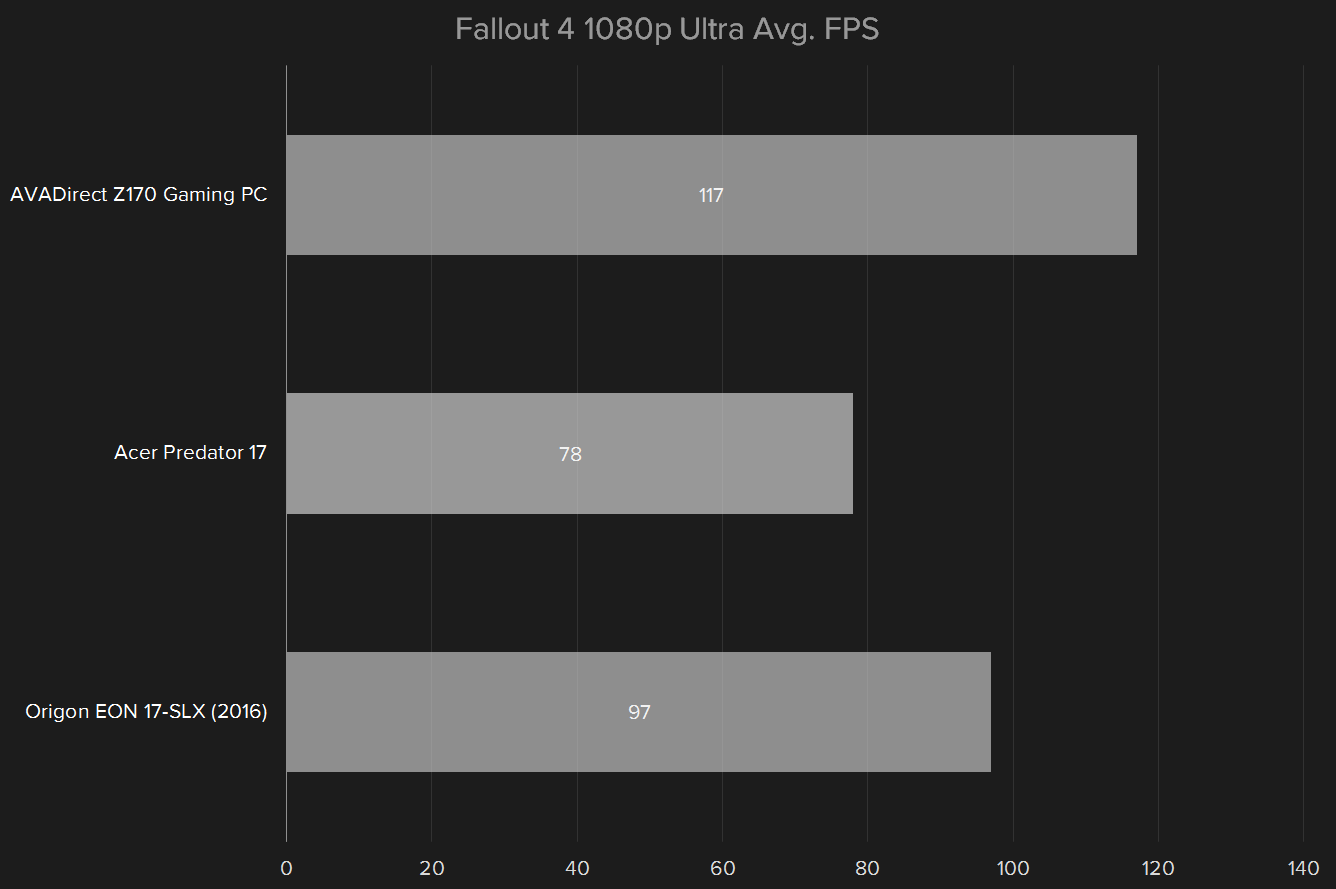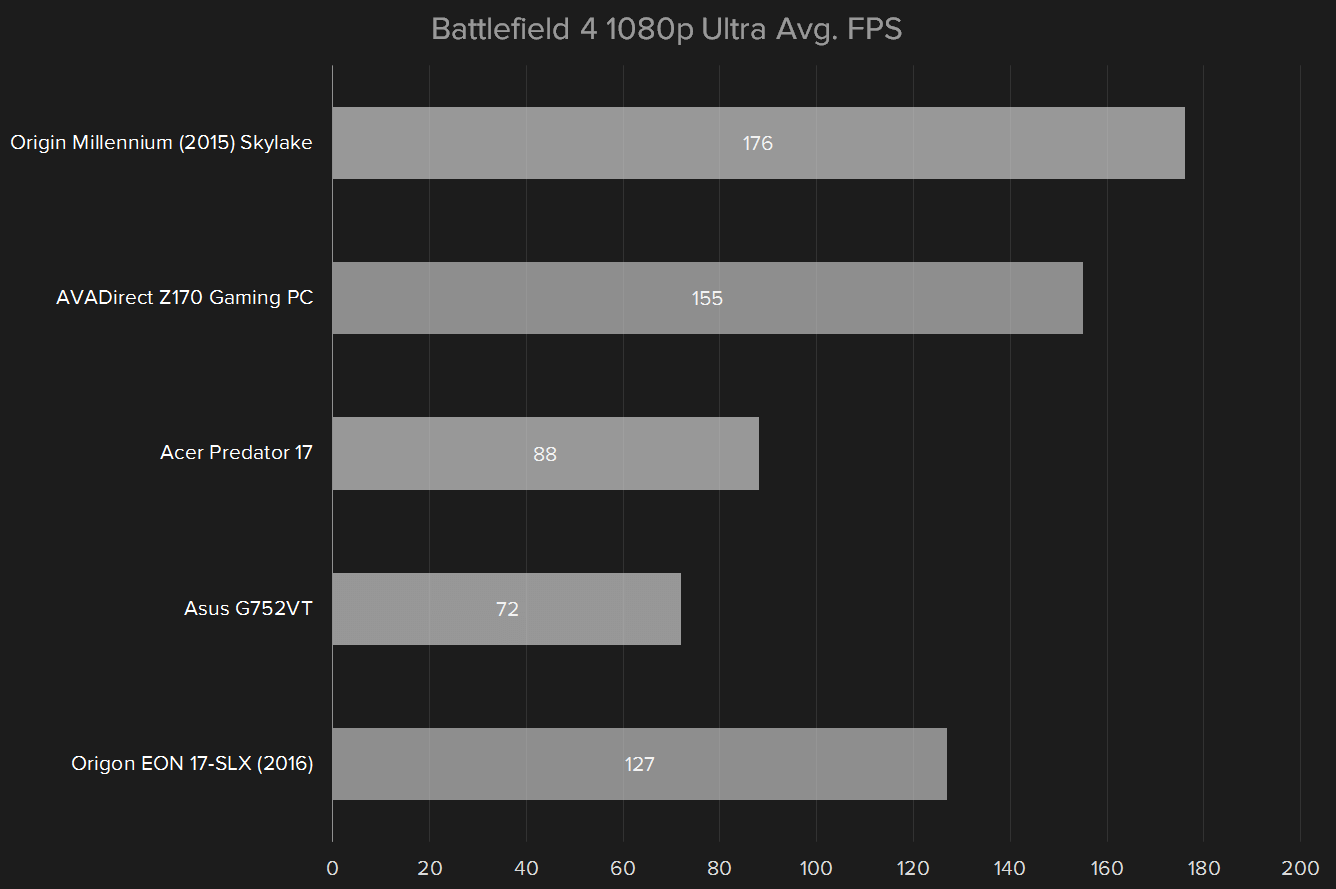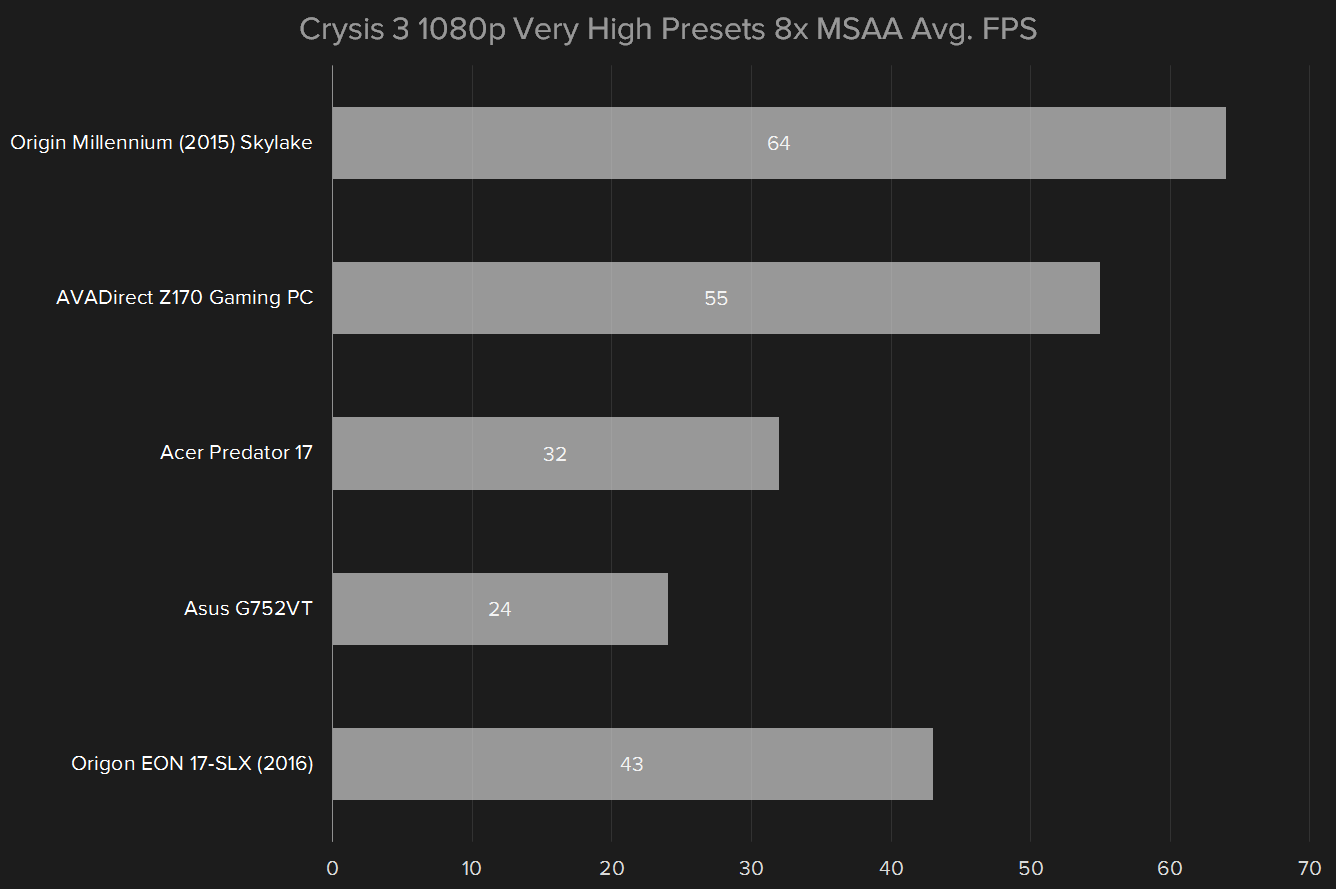“Powerful but impractical, the Origin EON17-SLX fits a niche.”
- Excellent 1080p G-Sync display
- Great speakers
- Desktop-class processor and GPU
- Excellent solid state drive selection
- Generic chassis
- Poor battery life
- More expensive than similar competition
Update 1/29/2016 3:20PM: Origin informed us a pricing error has caused configurations to be sold for more than they should. The price for our review unit is now $3,460, down from about $3,600 before.
Update 1/28/2016 2:00PM: A problem with overclocking software shipped with our review unit caused it to run at stock speeds. After working with Origin, we enabled the software, boosting processor performance. The new results are listed in the performance section, though it has not changed the score or recommendation.
The term “desktop replacement” has bounced around for years, and it’s always been a bit of an exaggeration. Yes, the so-called replacements had larger screens and quick processors, but they couldn’t match a desktop’s performance.
Until now.
Origin’s EON17-SLX is a wave in the rising tide of new laptops that literally replicate the performance of a desktop PC. They do this by equipping actual desktop components. Inside the EON17-SLX you’ll find a Core i7-6700K processor (overclocked to 4.5GHz), 16GB of RAM, a GTX 980 graphics card, and two hard drives. These components are identical to those equipped by high-end gaming towers.
It’s impressive to see desktop class hardware crammed into a 17-inch laptop, but it’d be silly to expect it to be without compromise. The EON17-SLX is huge, and its $3,600 price tag puts it well above the price of an average gaming laptop. Can this portable rig deliver desktop-caliber enjoyment, or is it trying to fill an unnecessary niche?
Off the shelf
Origin has slowly moved its desktop computers over to new custom enclosures unique to the company, an unusual move that has made its systems more attractive than many competitors. But it hasn’t been able to do the same for its laptops. The Origin EON17-SLX uses a design built for multiple manufacturers, including AVADirect and Digital Storm.
Mobile designs built for multiple companies usually aren’t lookers, and the EON17-SLX follows that trends. It’s not bad – the glowing LED strips in the display lid are a nice touch – but it doesn’t stand out like an Asus G-Series or Alienware laptop. The massive display bezels and vast expanses of unadorned matte black plastic work together to present a yawn-worthy first impression.
The generic chassis does deserve praise for its durable feel. Weight tends to work against laptops. More heft means more strain on the materials. Yet this laptop suffers no creaks, groans, or wobbly surfaces. That may be due to its lack of an internal optical drive. While some users may be disappointed by its omission, forgoing it means there’s no need to break up the chassis’ construction to accommodate a large, mostly hollow component.
Ditching the optical also means more room for ports, and there’s plenty here. The system has four USB 3.0, one Thunderbolt 3, two DisplayPort-out, two Ethernet jacks, an SDcard reader, and 5.1 or 7.1 audio with optical audio out (depending on configuration). Wireless connectivity is covered by 802.11ac Wi-Fi and Bluetooth 4.0.
Lots of space, but what to do with it?
A full-sized keyboard with numpad fits in the EON17-SLX with plenty of room to spare, but it’s one of the laptop’s weakest traits. The large keys are only slightly beveled, and key travel feels a bit limited next to the best competitors, like Acer’s Predator 17 and Asus’ G752. Pressing a key elicits a spongy feel that doesn’t inspire confidence. The layout is proper, however, so touch typists shouldn’t have much trouble adjusting.
Performance is identical to any Core i7-6700K desktop.
RGB key backlighting is standard on the EON17-SLX. Color can be adjusted in up to four zones, including the logo, with a choice of 256 colors. Brightness can be picked between three levels, or the backlight can be turned off entirely. The customization software used to change the lighting isn’t pretty, but it does the job. Not all keys are evenly lit, and there’s a fair amount of light leak from beneath the function row.
As for the touchpad – well, it has one. The surface is large and responsive, but not pleasing to touch and not well defined from the surrounding palmrest. A pair of clicky mouse buttons are included, though they offer minimal travel. A fingerprint reader can be found between them. The whole touchpad is a usable but mediocre effort, obviously designed with the belief most owners will connect a USB gaming mouse.
Meet the entertainment
While The Origin’s internal hardware is powerful and unusual, mundane 1080p is the only choice of display resolution. It would’ve been great to see a 1440p or 4K option. We can’t knock Origin too hard for that, though, because competitors generally don’t offer a resolution beyond 1080p, either. At least G-Sync is standard.
Though its specifications aren’t incredible, the display makes a good first impression. This is thanks to its balanced color reproduction. Scenes look as intended. Movies are particularly striking, as actors appear so real the effect is like looking through a window. Well, if the actors were a foot tall. Like every LCD display, the screen struggles with dark scenes. Details are often obscured when light is at a minimum and the panel can’t reproduce an inky shade of black. Dark gray is the closest it gets.
Testing backed up these impressions. The color gamut came in at a mediocre 92 percent of sRGB, or 71 percent of AdobeRGB, but color accuracy was strong with an average rating of 1.68 (lower is better). The Asus G752 scored 1.87 in color accuracy, and the Acer Predator 17 was relatively high at 3.74. The gamma curve figure came in at 2.3, off the ideal target of 2.2, indicating grayscale reproduction that’s a tad darker than it should be — close enough that it’s just a minor issue.
Even if you can handle the weight, you may not have a pack that handles this laptop’s girth.
The contrast ratio is 680:1 at the panel’s maximum brightness of 307 lux. Turning the brightness down to half reduces the contrast ratio to 610:1. These numbers are in league with competitors. The Asus G752 hit an identical contrast ratio of 680:1, while the Acer Predator 17 was slightly lower, at 570:1.
When all the facts and figures are balanced, the sum is a display with solid image quality. You won’t be picking your jaw up off the floor after watching the latest Marvel movie trailer, but it will have you smiling. The screen even has a matte coat, so glare is never an issue.
The display is backed up by an excellent sound system that’s clear, loud, and offers some bass. It’s so loud, in fact, that you’ll rarely need to turn it up much beyond half of maximum. When you do, you’ll be rewarded with audio that can fill a large room with sound and disturb the neighbors – if your walls are thin. Only a more sophisticated setup than a 2.1 system will feel like an upgrade.
Desktop performance in a laptop
The base Origin EON17-SLX comes with a Core i5-6500, but our review unit had a Core i7-6700K, which was overclocked to 4.5GHz(a $50 charge over the standard base clock). This resulted in predictably excellent performance.
As you can see, the system’s performance is basically identical to any other Core i7-6700K, and in some situations, it outperforms desktops. The EON17-SLX’s multi-core score of 18,457 in Geekbench outruns the AVADirect Z170 gaming rig, for example. In our Handbrake h.265 4K encoding test, the Origin needed 591 seconds to tear through our two minutes and 12 second test clip (the trailer for Elysium). The Origin Millennium Battlebox, an overclocked Core i7-6700K desktop, needed 480 seconds. That means the laptop is only 20 percent slower than the quickest quad-core desktop we’ve ever reviewed.
When the EON17-SLX is pitted against its real competitors – other laptops – the fight becomes a rout. The Acer Predator 17 only scores 13,169 in Geekbench multi-core, and requires 789 minutes to get through the Handbrake test, which is over three minutes longer. Today’s quad-core laptops are quick, but still can’t compare to the glory of desktop hardware.
The hard drive is quick, too
Every EON17-SLX can be equipped with up to three hard drives. Our review unit came with two. The primary OS drive was a 256GB Samsung 950 Pro NVMe drive, backed up by a 1TB Seagate hybrid mechanical disk.
The Samsung drive did astonishingly well, delivering a read speed in excess of two gigabytes per second. The write speed was a bit less impressive at 952 megabytes per second, but that score is still very strong. HDTune recorded a robust average read speed of 1,208 megabytes per second.
Though strong, these scores don’t dust the Acer Predator 17, one of our favorite notebooks. That system also had a Samsung 950 Pro, but the 512GB version. Interestingly, it was slower in reads, but faster in writes. The Asus G752, which we reviewed with a SATA solid state drive, isn’t in the same league. Its read speed of 599 megabytes per second was barely more than a quarter of the Origin’s performance.
Game performance
Clearly, the Origin EON17-SLX is a powerful system. Origin even sells a workstation model specifically designed for hardcore users who need to edit 4K video or run specialized compute-heavy applications from a hotel room. Our review unit, however, is built to game, and to that end it equips a laptop-friendly version of the GTX 980. That’s 980, without the M that usually designates a GPU built for mobile hardware. What does that mean for graphics performance?

A clear picture is painted by these results. The Asus G752VT is by far the slowest, as we reviewed it with a GTX 970M. The Acer Predator 17 is a fair bit quicker with its GTX 980M. But it’s still easily defeated by the EON17-SLX, which scores 12,278 in the 3DMark Fire Strike test. That’s closer to the AVADirect Z170 Gaming PC – a desktop! – than it is to the Acer Predator 17.
Does that gap continue in actual gameplay? Absolutely.
Unsurprisingly, Origin’s rig easily outperforms the Asus and Acer competitors. The margin of victory varies, but is always significant. Fallout 4, the tightest race, sees the EON17-SLX beat the Predator 17 by a margin of 24 percent. That’s significant, but nothing compared to Battlefield 4, where the margin of victory leaps to 44 percent.
Crysis 3 was the only game in our test suite that put the EON17-SLX to a test. It managed 43 frames per second at 1080p and maximum detail, which is playable, but certainly not quite up to par with a desktop rig. Otherwise, the gameplay not only exceeded the usual ideal of 60 FPS, but also the G-Sync display’s maximum refresh rate of 75Hz. The result is an exceedingly smooth experience.
Portability
The EON17-SLX includes desktop hardware, and its size suffers as a result. But 10 and a half pounds of heft seems reasonable given what’s inside – the Acer Predator 17 and Asus G752 both come in around eight pounds. A massive power brick keeps the Origin juiced, however, and adds another two pounds. Even if you can handle the weight, you may not have a pack that handles this laptop’s girth. It’s nearly two inches thick all the way through, which will stretch the laptop compartment in even the largest bags to the limit.
The laptop suffers no creaks, groans, or wobble.
Okay, so traveling with this laptop is hard. But how long does the rig last if you manage it? Despite a large 89 watt-hour battery, we recorded only two hours and 33 minutes in the Peacekeeper battery life test. That’s less than half the Acer Predator 17’s nearly six-hour result. The battery is really more of an internal backup, meant to help you do a little bit of work in a pinch, instead of a primary feature. If you plan to frequently use your laptop away from an outlet you should look for a different notebook.
Cooling
Cooling desktop hardware in a laptop is difficult, even when the laptop is two inches thick. Fortunately, the fans in the EON17-SLX are up to the job. At idle, they keep the maximum external temperature down to a tame 91 degrees Fahrenheit. Even that reading appears in an extremely small area. Most of the notebook is closer to 85 degrees. At full load, the temperature increases to 97.4 degrees across a wider swath of the upper chassis, especially above the upper right of the keyboard. That’s warmer than the Asus G752 or Acer Predator 17, but only by a few degrees.
The fans do make their presence known. At idle we recorded a noise level of 34.9 decibels, which is very quiet, but that kicked up to 47.1dB at maximum load. That’s about the same as Acer’s Predator 17, but two decibels higher than the Asus G752. The EON17-SLX is quieter than we expected, but the fan is still loud enough to be a distraction at times.
Gamers should also note this rig is full of vents. The entire underside is used to take in air, and the exhaust shoots out the back. You’ll have to use the laptop on a solid, even surface. Placing it on your lap or on fabric will severely restrict airflow.
Warranty
Origin’s basic warranty offers one year of parts replacement, lifetime 24/7 phone support, and lifetime free labor on repairs. However, the warranty only covers shipping for the first 45 days. Several competitors copy that policy, but the limited shipping coverage feels like a “gotcha.” Better warranties are available starting at 89 dollars for a one-year warranty that covers shipping, and max out at $330 for a three-year warranty.
Conclusion
The base price of the EON17-SLX is just north of $2,000, but our review unit arrived with a price tag of $3,900, which included a three-year warranty. Without that, you’re looking at about $3,600. Which is a lot. Yet the price doesn’t damage value as much as you’d expect. The Acer Predator 17 we reviewed was $2,600, which means the Origin is about 40 percent more expensive. Luckily, it’s also about 40 percent quicker in many benchmarks, including games, so the added cost seems justified.
But there’s a problem. This system’s chassis is not unique to Origin. A number of other companies offer the exact same laptop, with a few tweaks of their choosing. AVADirect will part ways with a mostly similar system – albeit with a less impressive hard drive – for about $2,900. Digital Storm sells an almost identical configuration for $3,400. The only reason to go with Origin, as opposed to another company, is brand preference and customer service.
The EON17-SLX also suffers from serious lack of portability. It’s too heavy and large to easily carry, and not comfortable to use on a couch or in bed. That means it’s more of a portable desktop with a built-in screen than a real laptop – which will scare off some buyers. If you’re a college student, for instance, this rig would be a terrible choice. You’d be far better served by the Acer Predator 17, which can not only game well, but is also a good all-around laptop with solid battery life.
There’s no disputing the power of Origin’s EON17-SLX. It’s massively quick, breaking records with performance identical to a desktop rig with a Core i7-6700K. Yet weight makes its usefulness as a laptop questionable, and other companies offer hardware very similar to the Origin at a lower price.







